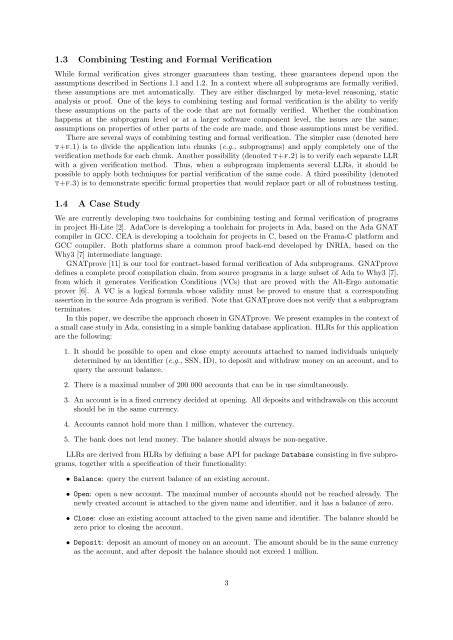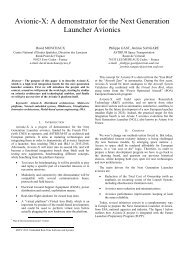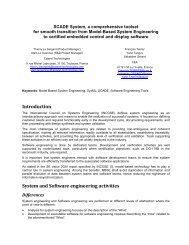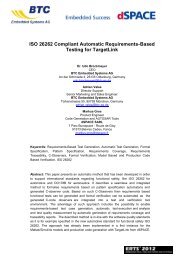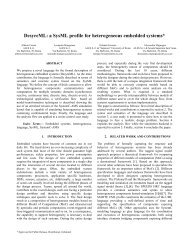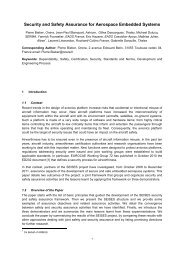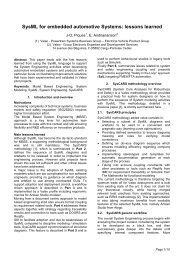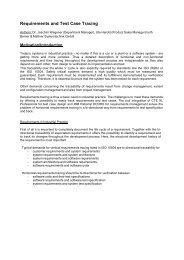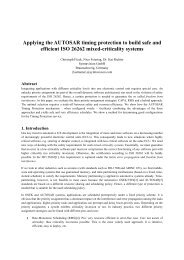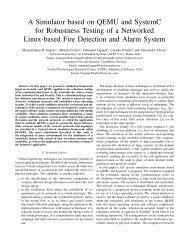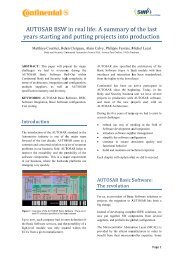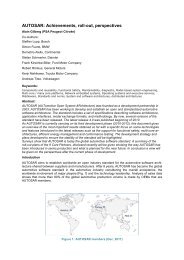Integrating Formal Program Verification with Testing
Integrating Formal Program Verification with Testing
Integrating Formal Program Verification with Testing
- No tags were found...
You also want an ePaper? Increase the reach of your titles
YUMPU automatically turns print PDFs into web optimized ePapers that Google loves.
1.3 Combining <strong>Testing</strong> and <strong>Formal</strong> <strong>Verification</strong>While formal verification gives stronger guarantees than testing, these guarantees depend upon theassumptions described in Sections 1.1 and 1.2. In a context where all subprograms are formally verified,these assumptions are met automatically. They are either discharged by meta-level reasoning, staticanalysis or proof. One of the keys to combining testing and formal verification is the ability to verifythese assumptions on the parts of the code that are not formally verified. Whether the combinationhappens at the subprogram level or at a larger software component level, the issues are the same:assumptions on properties of other parts of the code are made, and those assumptions must be verified.There are several ways of combining testing and formal verification. The simpler case (denoted heret+f.1) is to divide the application into chunks (e.g., subprograms) and apply completely one of theverification methods for each chunk. Another possibility (denoted t+f.2) is to verify each separate LLR<strong>with</strong> a given verification method. Thus, when a subprogram implements several LLRs, it should bepossible to apply both techniques for partial verification of the same code. A third possibility (denotedt+f.3) is to demonstrate specific formal properties that would replace part or all of robustness testing.1.4 A Case StudyWe are currently developing two toolchains for combining testing and formal verification of programsin project Hi-Lite [2]. AdaCore is developing a toolchain for projects in Ada, based on the Ada GNATcompiler in GCC. CEA is developing a toolchain for projects in C, based on the Frama-C platform andGCC compiler. Both platforms share a common proof back-end developed by INRIA, based on theWhy3 [7] intermediate language.GNATprove [11] is our tool for contract-based formal verification of Ada subprograms. GNATprovedefines a complete proof compilation chain, from source programs in a large subset of Ada to Why3 [7],from which it generates <strong>Verification</strong> Conditions (VCs) that are proved <strong>with</strong> the Alt-Ergo automaticprover [6]. A VC is a logical formula whose validity must be proved to ensure that a correspondingassertion in the source Ada program is verified. Note that GNATprove does not verify that a subprogramterminates.In this paper, we describe the approach chosen in GNATprove. We present examples in the context ofa small case study in Ada, consisting in a simple banking database application. HLRs for this applicationare the following:1. It should be possible to open and close empty accounts attached to named individuals uniquelydetermined by an identifier (e.g., SSN, ID), to deposit and <strong>with</strong>draw money on an account, and toquery the account balance.2. There is a maximal number of 200 000 accounts that can be in use simultaneously.3. An account is in a fixed currency decided at opening. All deposits and <strong>with</strong>drawals on this accountshould be in the same currency.4. Accounts cannot hold more than 1 million, whatever the currency.5. The bank does not lend money. The balance should always be non-negative.LLRs are derived from HLRs by defining a base API for package Database consisting in five subprograms,together <strong>with</strong> a specification of their functionality:• Balance: query the current balance of an existing account.• Open: open a new account. The maximal number of accounts should not be reached already. Thenewly created account is attached to the given name and identifier, and it has a balance of zero.• Close: close an existing account attached to the given name and identifier. The balance should bezero prior to closing the account.• Deposit: deposit an amount of money on an account. The amount should be in the same currencyas the account, and after deposit the balance should not exceed 1 million.3


